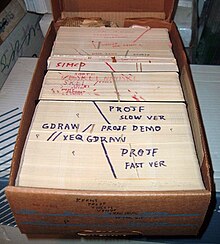The Antikythera mechanism from ancient Greece was a calculator utilizing gears of various sizes and configuration to determine its operation,[3] which tracked the metonic cycle still used in lunar-to-solar calendars, and which is consistent for calculating the dates of the Olympiads.[4] Al-Jazari built programmable Automata in 1206. One system employed in these devices was the use of pegs and cams placed into a wooden drum at specific locations. which would sequentially trigger levers that in turn operated percussion instruments. The output of this device was a small drummer playing various rhythms and drum patterns.[5][6] The Jacquard Loom, which Joseph Marie Jacquard developed in 1801, uses a series of pasteboard cards with holes punched in them. The hole pattern represented the pattern that the loom had to follow in weaving cloth. The loom could produce entirely different weaves using different sets of cards. Charles Babbage adopted the use of punched cards around 1830 to control hisAnalytical Engine. The synthesis of numerical calculation, predetermined operation and output, along with a way to organize and input instructions in a manner relatively easy for humans to conceive and produce, led to the modern development of computer programming. Development of computer programming accelerated through theIndustrial Revolution.
In the late 1880s, Herman Hollerith invented the recording of data on a medium that could then be read by a machine. Prior uses of machine readable media, above, had been for control, not data. "After some initial trials with paper tape, he settled on punched cards..."[7] To process these punched cards, first known as "Hollerith cards" he invented the tabulator, and the keypunch machines. These three inventions were the foundation of the modern information processing industry. In 1896 he founded theTabulating Machine Company (which later became the core of IBM). The addition of a control panel (plugboard) to his 1906 Type I Tabulator allowed it to do different jobs without having to be physically rebuilt. By the late 1940s, there were a variety of control panel programmable machines, called unit record equipment, to perform data-processing tasks.
The invention of the von Neumann architecture allowed computer programs to be stored in computer memory. Early programs had to be painstakingly crafted using the instructions (elementary operations) of the particular machine, often in binary notation. Every model of computer would likely use different instructions (machine language) to do the same task. Later, assembly languages were developed that let the programmer specify each instruction in a text format, entering abbreviations for each operation code instead of a number and specifying addresses in symbolic form (e.g., ADD X, TOTAL). Entering a program in assembly language is usually more convenient, faster, and less prone to human error than using machine language, but because an assembly language is little more than a different notation for a machine language, any two machines with different instruction sets also have different assembly languages.
In 1954, FORTRAN was invented; it was the first high level programming language to have a functional implementation, as opposed to just a design on paper.[8][9] (A high-level language is, in very general terms, any programming language that allows the programmer to write programs in terms that are more abstract than assembly language instructions, i.e. at a level of abstraction "higher" than that of an assembly language.) It allowed programmers to specify calculations by entering a formula directly (e.g.Y = X*2 + 5*X + 9). The program text, or source, is converted into machine instructions using a special program called a compiler, which translates the FORTRAN program into machine language. In fact, the name FORTRAN stands for "Formula Translation". Many other languages were developed, including some for commercial programming, such as COBOL. Programs were mostly still entered using punched cards or paper tape. (See computer programming in the punch card era). By the late 1960s, data storage devices and computer terminals became inexpensive enough that programs could be created by typing directly into the computers. Text editors were developed that allowed changes and corrections to be made much more easily than with punched cards. (Usually, an error in punching a card meant that the card had to be discarded and a new one punched to replace it.)
As time has progressed, computers have made giant leaps in the area of processing power. This has brought about newer programming languages that are more abstracted from the underlying hardware. Although these high-level languages usually incur greater overhead, the increase in speed of modern computers has made the use of these languages much more practical than in the past. These increasingly abstracted languages typically are easier to learn and allow the programmer to develop applications much more efficiently and with less source code. However, high-level languages are still impractical for a few programs, such as those where low-level hardware control is necessary or where maximum processing speed is vital.
Throughout the second half of the twentieth century, programming was an attractive career in most developed countries. Some forms of programming have been increasingly subject to offshore outsourcing (importing software and services from other countries, usually at a lower wage), making programming career decisions in developed countries more complicated, while increasing economic opportunities in less developed areas. It is unclear how far this trend will continue and how deeply it will impact programmer wages and opportunities.[citation needed]

Tidak ada komentar:
Posting Komentar